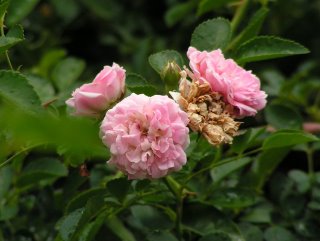 I got this rose from my grandmother's farm in Bardstown, KY as a small, sickly rooted cutting. My grandmother had it growing for fifty years, up a bell pole on the farm; planted in that red clay, it's wonder it grew as well as it apparently did. (That bell now lives in Florida, too. I have a 'Don Juan' and 'Prosperity' growing up its pole now. My mother tells me that the bell was only rung in emergencies; my son and daughter, on the other hand, ring it nearly every week, just to delight in the sound. When I mounted it a few years ago, I noticed that it was a school bell, with the year and PS number carefully etched onto the inside. I should have jotted down that information, since now 'Don Juan' is tangled up inside the bell's skirt.)
I got this rose from my grandmother's farm in Bardstown, KY as a small, sickly rooted cutting. My grandmother had it growing for fifty years, up a bell pole on the farm; planted in that red clay, it's wonder it grew as well as it apparently did. (That bell now lives in Florida, too. I have a 'Don Juan' and 'Prosperity' growing up its pole now. My mother tells me that the bell was only rung in emergencies; my son and daughter, on the other hand, ring it nearly every week, just to delight in the sound. When I mounted it a few years ago, I noticed that it was a school bell, with the year and PS number carefully etched onto the inside. I should have jotted down that information, since now 'Don Juan' is tangled up inside the bell's skirt.)I don't ever remember seeing this rose in bloom on the farm, but my mother says that some years it was a blanket of pink.
A few years ago, I planted the Greer rose at the base of our gazebo, on a lattice. It's ambled its way up onto the roof, mixing it up with several R. laevigata that I planted there. The roof gets well above 130 degrees in July, so you know these are tough roses. They've formed a dense mat of canes from which new, vertical growth arises. It's vigorous -- I have a tough time keeping it tied up, and new basal canes are always erupting upwards and outwards.
The R. laevigata hasn't bloomed yet. I don't know this for certain, but my guess is that laevigata only blooms on old canes -- apparently older than two years. I hope to see some blooms next spring.
Today, for the first time, I noticed these tiny pink blooms growing on the roof of the gazebo. I almost missed them. I expect that this is just the first of (hopefully) many blooms this season. I don't know when it bloomed in Kentucky, but apparently it's a early summer bloomer here. I wonder what it is?
No comments:
Post a Comment